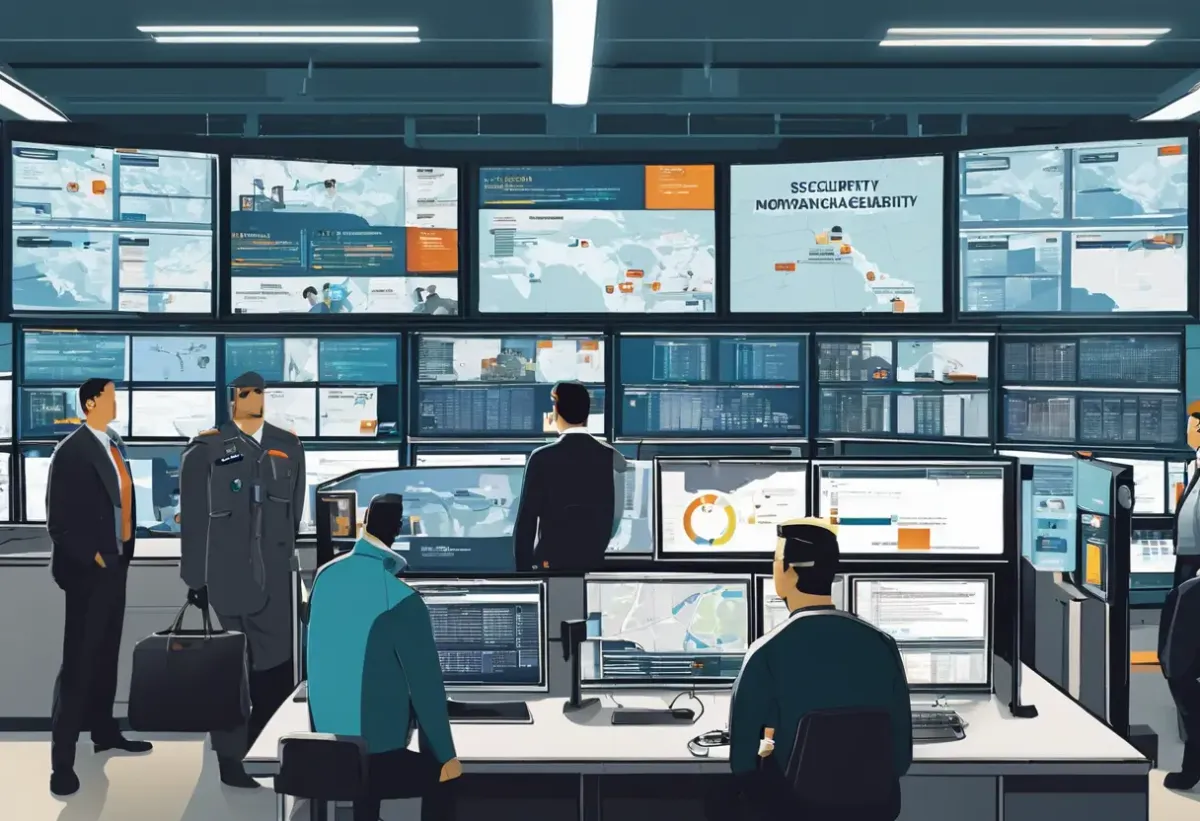Intelligent Monitoring: How Automated Video Surveillance is Revolutionizing Threat Detection

Introduction to Intelligent Monitoring and Video Surveillance
In the realm of security and surveillance, traditional methods have often hinged on human vigilance – a model fraught with limitations stemming from fatigue, distraction, and inefficiency. Today, however, the landscape of monitoring has been revolutionized by the advent of intelligent monitoring and video surveillance. These cutting-edge systems use advanced algorithms and machine learning to transform how we approach threat detection, situational awareness, and security response.
Intelligent monitoring systems differentiate themselves by their ability to analyze vast amounts of video footage in real-time, identifying patterns, and recognizing anomalies that would typically go unnoticed by the human eye. This is not merely about recording footage for post-event analysis; it’s about proactive monitoring that can pre-empt incidents before they escalate.
The following aspects define the core of intelligent monitoring systems:
- Real-time analysis: These systems process and interpret video data as it’s captured, allowing for immediate action or alerts.
- Machine learning: Through continued use, intelligent surveillance adapts and improves its threat detection capabilities, reducing false alarms and honing its recognition skills.
- Pattern recognition: Advanced software algorithms track and analyze movements, behaviors, or specific incidents automatically.
- Event prediction: By assessing the likelihood of various scenarios, surveillance systems can alert operators to potential risks.
- Integration capabilities: Modern systems often seamlessly integrate with other security measures, creating a cohesive and comprehensive security apparatus.
The integration of these capabilities in video surveillance systems is not merely a technological triumph but a transformative approach to ensuring safety and security in various sectors – from commercial environments and transportation hubs to urban streetscapes and private residences. As the technology continues to advance, the potential for these intelligent systems to not only detect but also predict and prevent threats is becoming a cornerstone of modern security strategies.
The Evolution of Video Surveillance: From Analog to Intelligent Systems
The trajectory of video surveillance has been marked by significant technological advancements since its inception. Initially, analog systems predominated, transmitting video over coaxial cables and recording footage on videotapes. These first-generation surveillance solutions had evident limitations, such as low video quality, limited storage capacity, and the need for manual video retrieval and review.
As technology progressed, digital video surveillance emerged, allowing for higher quality video, more efficient storage on digital video recorders (DVRs), and easier searching capabilities. The transition to digital represented a significant leap forward but remained fairly passive in nature, primarily used for recording and later review rather than real-time threat assessment.
The introduction of networked video, or IP cameras, marked a critical pivot toward more sophisticated surveillance. These systems could transmit data over the internet, enabling remote monitoring and integration with computer systems. This step laid the foundation for smart video surveillance, which uses software algorithms to analyze video content in real-time, presenting enhanced capabilities like:
- Motion detection
- Facial recognition
- License plate reading
- Object tracking
Recent advancements have ushered in an era of “intelligent systems.” These systems underpin automated threat detection by employing machine learning and artificial intelligence (AI) to interpret video data. The intelligence of these systems lies in their ability to:
- Learn typical patterns of behavior and identify anomalies
- Send instant alerts to security personnel to address potential threats promptly
- Integrate with other security systems, such as access control and alarm systems
- Analyze vast amounts of data for insights to improve security measures proactively
As continual improvements in computational capability and AI algorithms take place, intelligent video surveillance systems are becoming more adept at preempting and mitigating security risks autonomously. This evolution symbolizes a momentous shift from mere recording devices to proactive guardians in the domain of security surveillance.
Automated Video Analysis: The Core of Intelligent Monitoring
In the realm of security and surveillance, automated video analysis stands as the linchpin of intelligent monitoring systems. This advanced technology harnesses the power of algorithms and artificial intelligence to scrutinize video footage in real-time, far surpassing the capabilities of human oversight in both speed and accuracy.
At its core, automated video analysis employs sophisticated software to detect, classify, and track objects and individuals across multiple camera feeds. This process involves several key functionalities:
- Motion Detection: The system identifies movements within the camera’s field of view, signaling potential security events.
- Pattern Recognition: Algorithms interpret shapes and behaviors, distinguishing between people, vehicles, and animals, or identifying suspicious activities.
- Facial Recognition: When enabled, the system can recognize individual faces, cross-referencing them with databases for identity verification or watchlist alerts.
- License Plate Recognition: Vehicles captured by the camera can have their license plates read and recorded, a vital feature for tracking movement in and out of a monitored area.
These components interlock to create a seamless surveillance network that can provide real-time alerts to security personnel, triggering an immediate response to any identified threats. Moreover, the technological evolution within this domain has introduced the concept of ‘learning systems’ that adapt to their environment, enhancing their detection efficacy over time.
By handling vast amounts of data and eliminating the risk of human fatigue, automated video analysis serves as the foundation upon which intelligent monitoring systems are built. It grants organizations the ability to preemptively address vulnerabilities and react to potential threats with decision-making precision that was, until now, unattainable. As these systems become more ubiquitous, automated video analysis will continue to redefine the landscape of security and threat detection.
AI Algorithms and Machine Learning in Threat Detection
In the modern era of security, artificial intelligence (AI) algorithms and machine learning (ML) techniques have taken center stage in the fight against threats. Intelligent video surveillance systems are now equipped with sophisticated software that can analyze live or recorded video footage in real time to identify potential threats with astounding accuracy.
- Pattern Recognition: ML algorithms are trained to recognize patterns and anomalies in video streams. For example, these systems can distinguish between normal pedestrian movement and behavior that is indicative of a potential threat, such as loitering, unattended bags, or an individual brandishing a weapon.
- Facial Recognition Technology: AI-powered systems leverage facial recognition to identify known individuals against a database of faces. When a match is found, the system can alert security personnel to the presence of a person of interest or someone with a known history of criminal activity.
- Object Detection: Advanced algorithms are capable of object recognition, crucial in detecting weapons, packages, and other objects of concern. The system raises alerts when items are found in areas where they do not belong or are left unattended, potentially presenting a threat.
- Behavioral Analytics: Through machine learning, surveillance systems learn typical behavior patterns and flag deviations. Unusual activities, such as erratic movements or forced entry, are identified quickly, enabling faster response times.
These intelligent systems constantly learn and improve their detection capabilities over time. With each interaction, an AI surveillance system becomes more adept at distinguishing benign from malicious intent. The integration of AI and ML in threat detection not only enhances security measures but does so with fewer errors than traditional methods, resulting in increased safety and a more effective use of resources.
Facial Recognition Technology: Enhancing Security Measures
In the rapidly evolving landscape of security, facial recognition technology has emerged as a transformative tool. Leveraging complex algorithms and advanced machine learning techniques, this form of biometric identification has proven invaluable for enhancing security protocols in various environments.
Facial recognition systems work by capturing a digital image of an individual’s face and comparing it against a database of known faces. These systems can quickly confirm or determine an individual’s identity with a high degree of accuracy, making it an ideal solution for access control and identity verification.
Key benefits of integrating facial recognition into automated video surveillance include:
- Real-time Identification: Facial recognition technology can identify individuals in live video feeds, enabling immediate detection of known threats or unauthorized persons.
- High Accuracy: The ongoing advancements in AI algorithms have increased the precision of facial recognition, reducing the chances of false positives.
- Non-intrusive Monitoring: Since facial recognition can be performed at a distance, it provides a less obtrusive means of monitoring compared to other biometric systems like fingerprint or iris scans.
- Enhanced Investigation Capabilities: In the event of an incident, facial recognition can help quickly identify and track individuals captured on video, aiding in investigations.
- Integration with Other Systems: It can be seamlessly integrated with other security systems, such as access control mechanisms, heightening the overall security infrastructure.
Despite the clear advantages of facial recognition, the technology is not without challenges. Privacy concerns, the need for a robust legal framework, and ensuring system security against cyber threats are critical issues that must be addressed. However, as technology continues to mature, facial recognition stands as a beacon for the future of intelligent monitoring and threat detection, providing an additional layer of security that is both proactive and adaptive.
Anomaly Detection: Identifying Irregular Patterns with AI
In the landscape of security and surveillance, anomaly detection has become a key asset, empowered by artificial intelligence. Traditional monitoring systems rely heavily on the vigilance of human operators, who may suffer from fatigue and limited attention span. By contrast, AI-enhanced video surveillance systems work tirelessly, continuously analyzing streams of visual data to spot atypical behaviors or events that could indicate potential threats.
Modern AI-driven anomaly detection operates by learning what is considered normal within a given environment. It does so through the following steps:
- Establishing a Baseline: AI algorithms are first trained on footage from the surveillance environment to understand typical patterns of activity and to recognize regular movement paths, lighting conditions, and the presence of people and vehicles.
- Real-time Analysis: Once the baseline is established, the AI system continuously compares new data to this standard, meticulously assessing each frame for deviations.
- Immediate Response: Upon detecting any unusual activity, such as someone loitering in a restricted area or an unattended bag at a public venue, the system triggers real-time alerts. These notifications enable rapid response to potential threats before they escalate.
- Continuous Learning: The AI system also incorporates feedback to refine its understanding of what constitutes a normal pattern, thus reducing false positives and enhancing its predictive accuracy.
The integration of AI in surveillance systems represents a paradigm shift in threat detection. Organizations now have at their disposal a vigilant, error-resistant assistant that not only identifies security risks with high precision but also evolves and adapts to the ever-changing dynamics of its environment. This advancement is not just revolutionizing threat detection; it’s setting new standards for safety and security worldwide.
Real-time Monitoring and Response Coordination
In the age of digital transformation, automated video surveillance systems have shifted from mere recording devices to proactive guardians of public and private spaces. These intelligent systems are now equipped with sophisticated algorithms that not only identify potential threats but also enable real-time monitoring and swift response coordination.
One of the key features of advanced surveillance systems is their ability to process and analyze video footage in real-time. This means that instead of relying on human vigilance, which is subject to fatigue and distraction, the system continuously scans the environment for predefined indicators of unusual activity. Upon detecting an anomaly, the system can immediately alert security personnel, who can rapidly assess the situation and respond accordingly.
Real-time monitoring offers several benefits:
- Improved situational awareness: Security teams are provided with timely information, helping them understand the context of a situation as it unfolds.
- Faster reaction times: Immediate identification and notification shrink the window between threat detection and response.
- Optimal resource allocation: Security resources can be directed where they are needed most, without spreading them too thin across large areas.
Moreover, when integrated with other security systems and communication protocols, automated video surveillance becomes part of a broader response coordination strategy. For instance, it can trigger lockdown procedures, activate barriers, or interface with law enforcement databases to provide contextual insights. This seamless integration ensures that every component of a security apparatus works in concert, thus enhancing overall safety and potentially averting crises before they escalate.
Intelligent monitoring is indeed revolutionizing the landscape of threat detection, ushering in a new era where real-time awareness and rapid response harmonize to create a safer tomorrow.
The Role of Big Data in Advancing Video Surveillance Capabilities
The integration of big data with video surveillance has been a game-changer in the field of intelligent monitoring. As the volume of video data generated by surveillance cameras continues to grow exponentially, the ability to analyze this information effectively becomes crucial for enhancing security and operational efficiency.
Big data analytics have enabled the processing and analysis of vast quantities of video footage at unprecedented rates, transforming raw surveillance into actionable insight. This has several implications for threat detection and overall surveillance effectiveness:
- Enhanced Pattern Recognition: Big data algorithms can identify patterns and anomalies within video feeds, which may represent potential security threats. By analyzing historical data, these systems can recognize subtle behavioral indicators that a human operator might overlook.
- Real-time Analysis: Surveillance setups equipped with big data capabilities can perform real-time analysis, flagging suspicious activities instantaneously. This quick response can prevent incidents before they escalate.
- Predictive Analytics: By sifting through vast datasets, predictive models can forecast potential risks and criminal activities, enabling preemptive measures to be taken.
- Improved Decision Making: With the insights provided by big data analysis, law enforcement and security personnel can make more informed decisions, prioritizing resources where they are needed most.
- Integration with Other Data Sources: Big data allows the synthesis of video surveillance with other data sources such as social media, weather information, and traffic feeds. This context-rich data enhances situational awareness.
- Reduction in False Positives: Advanced analytics minimize the occurrence of false positives, thus reducing the workload on monitoring staff and allowing them to focus on genuine threats.
The role of big data in video surveillance represents a significant move towards more intelligent, proactive security systems. The fusion of large datasets with sophisticated analytics tools is not merely augmenting human capabilities; it’s setting a new standard for automated threat detection and prevention.
Privacy Concerns and Ethical Implications of Intelligent Monitoring
As intelligent monitoring technologies evolve and penetrate various aspects of our lives, they bring forth significant privacy concerns. Automated video surveillance systems, which utilize artificial intelligence to identify potential threats, can also inadvertently record and analyze the behaviors of law-abiding citizens.
- Intrusion on Privacy: When surveillance systems are ubiquitous, individuals may feel they are constantly being monitored, potentially infringing on personal privacy and freedom. The constant collection of video data blurs the line between public and private life.
- Data Security: The vast amounts of data generated by intelligent monitoring systems present substantial risks if hacked or improperly managed. Personal and sensitive information could fall into the wrong hands, leading to identity theft, blackmail, or misuse.
- Consent Issues: Often, individuals filmed by these surveillance systems are unaware of or have not consented to being monitored. This lack of consent is a major ethical consideration, as it bypasses individual autonomy.
- Bias and Discrimination: AI algorithms that have not been scrupulously tested and audited can perpetuate existing biases. They might incorrectly identify or target minority groups, leading to discrimination and social injustice.
- Accountability: With automated systems, there is a risk of diminished accountability. It becomes challenging to assign responsibility when AI-driven decisions lead to adverse outcomes or rights violations.
- Transparency: There exists a general lack of transparency about how these systems operate, what data is being collected, and how it is being used. Without clear explanations, trust in surveillance technologies erodes, and the potential for abuse grows.
Overall, while intelligent monitoring systems promise improved security and threat detection, they raise critical concerns about the preservation of privacy, ethical data handling, and fairness. Addressing these issues is paramount to ensuring such technologies are employed responsibly and respectfully of individuals’ rights.
Case Studies: Successful Implementation of Intelligent Surveillance Systems
The advent of advanced video analytics has propelled surveillance systems beyond passive observation, transforming them into proactive tools for threat detection. Here, we delve into a few case studies that demonstrate the acumen of intelligent monitoring in diverse scenarios.
In the urban landscape of Atlanta, Georgia, the adoption of an intelligent surveillance system known as ‘Operation Shield’ integrated public and private cameras into an extensive network. Utilizing facial recognition and automatic license plate readers, the system has provided police with crucial real-time data to address crime effectively.
A retail giant, leveraging intelligent surveillance, reported a significant decrease in in-store thefts. With systems capable of analyzing suspicious movements and behaviors, alerts are sent instantly to the security personnel, enabling swift response before potential incidents escalate.
Airports around the globe have also joined in embracing smart video monitoring. One notable example is Singapore’s Changi Airport, utilizing intelligent systems equipped with thermal imaging and behavioral analysis to enhance passenger safety and streamline operations - a testament to its robust security approach during massive foot traffic situations.
Furthermore, companies specializing in critical infrastructure have reported fewer intrusions after implementing surveillance solutions adept at long-range detection and threat classification. This has been particularly effective in safeguarding remote facilities where human monitoring is challenging.
These cases underscore the efficacy of intelligent surveillance in preempting risks, ensuring public safety, and safeguarding assets. Its scalable nature allows for tailored approaches suitable for varied operational environments, marking a revolutionary stride in surveillance technology.
Future Trends: Predictive Analytics and Advanced Threat Prediction
As the realm of automated video surveillance continues to expand, the integration of predictive analytics is set to redefine the capabilities of threat detection systems. Predictive analytics utilizes vast stores of historical data, employing algorithms and machine learning techniques to identify patterns and forecast potential incidents before they occur.
- Machine Learning & AI Integration: Advanced algorithms are increasingly capable of learning from what they monitor, allowing them to predict and identify unusual behaviors or potential threats with higher accuracy. Surveillance systems will not merely record; they will actively analyze and anticipate.
- Behavioral Analysis for Preemptive Action: By understanding typical behavior patterns in a given area, these intelligent systems can detect anomalies in real-time, alerting security personnel to potential threats. This data-driven approach enhances the ability to take preemptive measures, potentially thwarting events before they unfold.
- Enhanced Data Synthesis: Future surveillance systems will synthesize data from various sources, including social media, weather reports, and other IoT devices, to create comprehensive risk assessments. This multifaceted analysis will enable a robust response to both cyber and physical threats.
- Autonomous Response Capabilities: Advances in robotics and automated systems may enable not just prediction but an autonomous response. Drones or robots could be dispatched to investigate alarms, reducing the time between detection and intervention.
- Privacy and Ethics Considerations: As capabilities grow, so do concerns about privacy and ethical use of predictive analytics. The design of future systems will need to balance effectiveness with respect for individual rights, possibly incorporating privacy-by-design principles.
Investments in these trends signify a future wherein automated video surveillance evolves from passive monitoring tools to dynamic, proactive guardians. This shift will likely yield significant advancements in protecting assets, infrastructure, and lives by staying steps ahead of potential threats.
Integrating Intelligent Monitoring with Other Security Systems
Integrating intelligent monitoring systems with existing security infrastructure can create a multi-layered defense that significantly enhances overall security. The process involves ensuring that automated video surveillance can communicate and operate with other systems such as access control, alarm systems, and cyber security networks. Here are some steps and considerations necessary for effective integration:
- Compatibility Assessment: Evaluate the compatibility of the intelligent monitoring system with current security hardware and software. This may involve updating or replacing legacy systems that are not compatible with modern technology standards.
- Unified Management Platform: Implement a centralized management platform that allows security personnel to control all security systems from one place. This integration improves response times and streamlines the management of security alerts.
- Data Sharing Protocols: Establish protocols for data sharing between systems, ensuring that video analytics can trigger actions in other security systems, such as locking doors in the event of an unauthorized intrusion.
- Cross-System Communication: Facilitate a two-way communication between the intelligent monitoring system and other security components. This ensures that if one system detects a threat, others can react accordingly.
- Training and Workflow Alterations: Provide adequate training to security personnel on the new integrated system. Update workflow procedures to incorporate the capabilities and data inputs from the intelligent monitoring system.
By integrating intelligent monitoring with other security systems, organizations can leverage the benefits of advanced video analytics in concert with existing security measures. This results in a more comprehensive surveillance solution that can preemptively identify and respond to threats, often before they materialize into actual incidents. Such integration demands carefully planned strategies and robust technological infrastructure, but the outcome enhances the security posture significantly.
Challenges and Limitations of Automated Video Surveillance
Automated video surveillance has brought a paradigm shift in threat detection, yet it grapples with several challenges and limitations.
- Privacy Concerns: The extensive capture and analysis of video data raise significant privacy issues. The surveillance systems must comply with legal standards and ethical practices to protect individuals’ rights while ensuring security.
- Data Overload: With the constant influx of video data, system overload is a prevalent problem. It requires sophisticated algorithms and ample storage to manage and process the amount of data effectively without loss of critical information.
- False Positives and Negatives: Despite advancements, the potential for false alarms remains. Automated systems might misinterpret innocent behaviors as suspicious, or miss genuine threats, leading to either unnecessary responses or overlooked dangers.
- Reliance on Quality of Input: The effectiveness of these systems is heavily dependent on the quality of the videos. Low-resolution footage or poor lighting conditions can impede the system’s ability to identify and assess situations accurately.
- Integration Issues: Integrating new surveillance technologies with existing systems can be complex. Compatibility and interoperability issues can create gaps in monitoring and expose vulnerabilities.
- Cost Implications: High-end surveillance systems come with significant costs. The initial setup, maintenance, and necessary upgrades represent substantial financial investments, especially for small or resource-constrained organizations.
- Cybersecurity Threats: As with any digital system, automated video surveillance systems are susceptible to hacking and other cyber-attacks, posing risks to both the integrity of the surveillance data and potentially enabling breaches of secure environments.
The reliance on artificial intelligence and machine learning adds a layer of unpredictability to the technology. Biases in the algorithms can lead to discriminatory practices, and the systems must be continuously updated to adapt to new threats and avoid being outwitted by intelligent adversaries. Addressing these challenges is crucial for the sustainable advancement and adoption of automated video surveillance in threat detection.
Conclusion: The Impact of Intelligent Monitoring on Modern Security
Intelligent monitoring systems are fundamentally transforming the landscape of modern security. By integrating automation and machine learning, these systems provide rapid and reliable surveillance solutions that vastly improve threat detection. The advent of intelligent monitoring technologies has led to impressive strides in various facets of security operations:
- Enhanced Accuracy and Speed: Intelligent monitoring systems can analyze vast quantities of video data with incredible speed, surpassing the capabilities of human monitoring. These systems detect anomalous behaviors and potential security threats with a high degree of accuracy, minimizing the chances of false alarms.
- Proactive Threat Prevention: These systems help security personnel to act proactively rather than reactively. With advanced predictive analytics, intelligent monitoring can identify patterns indicative of future incidents, therefore allowing for timely intervention.
- Resource Optimization: Automated surveillance reduces the need for constant human oversight, thus allowing organizations to allocate personnel more effectively. This optimization leads to a reduction in overhead costs and the potential for human error.
- Scalability and Flexibility: Intelligent monitoring systems are scalable to the needs of the organization. Whether it’s a small retail store or a large-scale infrastructure, these systems can be tailored to cover the required area and adapted to the specific security needs.
- Improved Operational Intelligence: The data collected through intelligent monitoring not only serves security purposes but also provides valuable insights into operational efficiencies and customer behaviors.
In conclusion, intelligent monitoring is carving a new paradigm in the security arena. It enhances the capacity for early detection, fosters a swift response, and contributes to an overall safer and more secure society. The emergence of these technologies marks a significant milestone in the evolution of security systems, making the world a vigilantly guarded place for the people and assets within it.




